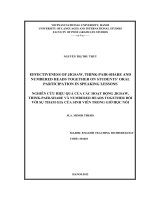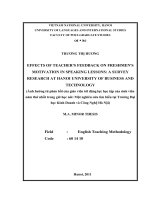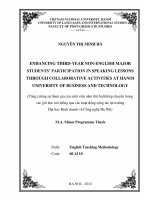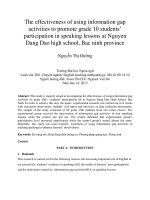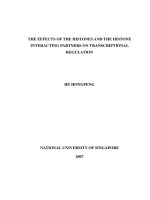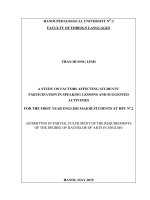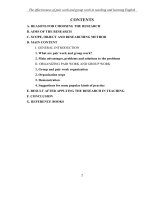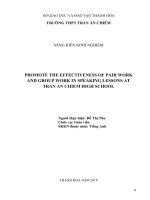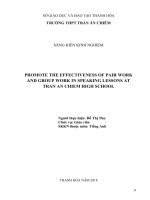Effectiveness of jigsaw, think-pair-share and numbered heads together on students' oral participation in speaking lessons Nghiên cứu hiệu quả của các hoạt
Bạn đang xem bản rút gọn của tài liệu. Xem và tải ngay bản đầy đủ của tài liệu tại đây (1.22 MB, 89 trang )
VIETNAM NATIONAL UNIVERSITY, HANOI
UNIVERSITY OF LANGUAGES ANS INTERNATIONAL STUDIES
FACULTY OF POST-GRADUATE STUDIES
NGUYỄN THỊ THU THỦY
EFFECTIVENESS OF JIGSAW, THINK-PAIR-SHARE AND
NUMBERED HEADS TOGETHER ON STUDENTS’ ORAL
PARTICIPATION IN SPEAKING LESSONS
NGHIÊN CỨU HIỆU QUẢ CỦA CÁC HOẠT ĐỘNG JIGSAW,
THINK-PAIR-SHARE VÀ NUMBERED HEADS TOGETHER ĐỐI
VỚI SỰ THAM GIA CỦA SINH VIÊN TRONG GIỜ HỌC NÓI
M.A. MINOR THESIS
MAJOR: ENGLISH TEACHING METHODOLOGY
CODE: 601410
HANOI-2012
iv
TABLE OF CONTENTS
Page
Acknowledgements ii
Abstract iii
Table of content iv
List of abbreviation viii
List of graphs, figures and tables ix
PART ONE: INTRODUCTION 1
1. Rationale and statement of the problem 1
2. Aims of the study 3
3. Research question 3
4. Scope of the study 3
5. Research method 4
6. Design of the study 4
PART TWO: DEVELOPMENT 6
CHAPTER 1: LITERATURE REVIEW 6
1.1. Teaching and learning speaking as a language skill 6
1.1.1. English speaking teaching 6
1.1.2. English speaking learning 7
1.1.3. What make a good speaking lesson? 7
1.2. Participation 8
1.2.1. Participation in class 8
v
1.2.2. Factors affecting students‟ participation in class 9
1.2.3. What can be done to get students to speak more in speaking classes? 9
1.3. Cooperative learning 9
1.3.1. Cooperative learning and its techniques 9
1.3.2. Key components of cooperative learning 11
1.3.3. Advantages of cooperative learning 12
1.4. Previous studies 12
CHAPTER 2: METHODOLOGY 14
2.0. Research question 14
2.1. Research method 14
2.2. Research context 16
2.3. Participants 17
2.4. Instruments 18
2.4.1. Survey questionnaire 18
2.4.2. Classroom observation 18
2.4.3. Students‟ self-reports 19
2.5. Action research procedure 20
2.5.1. Phase 1 20
2.5.1.1. Problem identification 20
2.5.1.2. Initial data collection 20
2.5.1.3. Generating hypothesis 21
3.5.2. Phase 2 21
2.5.2.1. Planning action 21
vi
2.5.2.2. Intervention 22
2.6. Data analysis 23
CHAPTER 3: RESULTS 24
3.1. Results from Phase 1 24
3.1.1. Factors affecting students‟ oral participation 24
3.1.2. Results from class observation: Students' on-task behavior 27
3.1.3. Resutls from students‟ self-report: Interaction in CL group-work 28
3.2. Results from Phase 2 29
3.2.1. Results from class observation: Students‟ on-task behavior 29
3.2.2. Results from students‟ self-report: Interaction in CL group work 30
3.2.3. Results from Questionnaire 2: Students‟ opinions and self-evaluation 33
CHAPTER 4: DISCUSSION 35
4.1. What are the factors causing students‟ poor participation? 35
4.2. To what extent can Jigsaw, Think-Pair-Share and Numbered-Heads-Together
improve students‟ oral participation? 36
4.2.1. Students' on-task behavior from lesson 3 to lesson 12 37
4.2.2. Students' interaction in CL groupwork from lesson 3 to lesson 12 38
4.2.3. Students' opinions and self-evaluation on the effectiveness of Jigsaw, Think-
pair-share, and Numbered Heads Together 39
PART THREE: CONCLUSION 41
1. Conclusion of the study 41
2. Recommendation 41
vii
3. Limitations and suggestions for further study 43
REFERENCES 45
APPENDICE I
Appendix 1: Questionnaire 1 I
Appendix 2: Questionnaire 2 III
Appendix 3: Class observation sheet IV
Appendix 4: Students‟ self-report V
Appendix 5: Speaking lesson plan (Pre-action stage) – Lesson 3 VI
Appendix 6: Speaking lesson plan (Action stage) – Lesson 7 XXII
Appendix 7: Speaking lesson plan (Action stage) – Lesson 8 XIX
Appendix 8: Speaking lesson plan (Action stage) – Lesson 10 XXVII
viii
LIST OF ABBRIVIATION
EFL: English as a foreign language
ESL: English as a second language
CLT: Communicative Language Teaching
CL: Cooperative Learning
HPU2: Hanoi Pedagogical University No.2
ix
LIST OF FIGURES, TABLES AND GRAPHS
Figure1: Action research cycle 15
Table 1: Speaking term 2 17
Table 2: Students‟ interaction in lesson 3 28
Table 3: Students‟ interaction in lesson 7 30
Table 4: Students‟ interaction in lesson 8 31
Table 5: Students‟ interaction in lesson 9 31
Table 6: Students‟ interaction in lesson 10 31
Table 7: Students‟ interaction in lesson 11 32
Table 8: Students‟ interaction in lesson 12 32
Graph 1: Students‟ on-task behavior 37
Graph 2: Students‟ interaction in CL group-work 38
1
PART ONE: INTRODUCTION
1. Rationale and statement of the problem
In learning any foreign languages, speaking is a vital tool for students to express
their thoughts, ideas and feelings, and to have successful social communication.
Unlike ESL learners who have more frequent use of the target language, EFL
learners have few opportunities to use English in daily life. In some big cities in
Vietnam, EFL learners may enjoy more favorable learning conditions with the
support of modern technology, online classes, and more chance to communicate in
English. In contrast, EFL learners in the countryside and mountainous areas of
Vietnam have many difficulties in learning English, especially the lack of exposure
to English. To them, speaking classes appears to be the only place where they can
freely speak and interact in English. It is one of the reasons why students are always
expected to raise their voice in English speaking classes. Having to deal with silent
speaking class is a big concern of almost all ESL and EFL teachers, especially in a
non-native language environment. As a teacher of speaking, the present researcher
has been facing with the same situation. She noticed that when she raises a question
to the class, they rarely volunteer to answer the questions. They even refuse to
answer the question by keeping standing and saying nothing. Saying “Sorry, I
can‟t” seems very difficult to them. A great number of techniques have been used to
encourage students to feel free to speak in class such as simplifying the difficult
topics, giving positive feedbacks, using funny games, delivering lecture with
videos, using group-work etc. However, the number of students who speak in
speaking lessons and the frequency they have oral participation in speaking classes
are still limited. Meanwhile previous studies proved a positive relationship between
students‟ oral participation and their studying result. “When students participate
actively in class, their academic achievement seems to be higher than that of those
who are passive in class” (Bailey, 2005). Thus, the current situation needs to be
changed for students‟ improvement in speaking skills and the success of speaking
2
lessons. As suggested in other studies, students‟ poor participation can be caused by
a variety of factors including cultural, pedagogical, psychological, cognitive, and/or
linguistic factors, of which teacher‟s careless or poor choice of teaching techniques
may lead to students' reluctance in taking any parts of a lesson. Researchers have
worked out a great number of ways and strategies to promote students‟ oral
participation in language class. In her capacity as a teacher, within this minor thesis,
the researcher would like to touch upon teaching technique as the main cause of
students‟ poor participation, then base on that to find out ways to treat the problem.
It can be considered the most feasible solution in her current teaching situation
while other problems related to materials, syllabus, students‟ personality, learning
and teaching equipments are almost time-consuming and beyond the teacher‟s
power of control.
Regarding how to have an effective speaking lesson, Kayi (2006) pointed out that
teachers should:
- maximum opportunity to students to speak the target language by providing a
rich environment that contains collaborative work, authentic materials and
tasks, and shared knowledge.
- try to involve each student in every speaking activity; for this aim, practice
different ways of student participation.
- reduce teacher speaking time in class while increasing student speaking time.
CL can be considered as an ideal tool for teacher to follow the above listed
recommendations. Richards & Rodger (2001) stated that CL “has been embraced as
a way of promoting communicative interaction in the classroom and is seen as an
extension of the principles of CLT”. As cited in Richards & Rodger (2001, p.195),
one of the advantages of CL for ESL students is that it can enhance frequency of
second language practice through different types of interaction (Mac Groarty,
1989). It can be implicated that CL creates maximum and equal chance for students
to interact because they have to work together, cooperate, and depend on each other
3
to complete certain task. CL offers teachers a wide range of cooperative structures
or techniques. However, the researcher would just like to focus on three cooperative
techniques which are among the most suitable to her teaching context and this
small-scale study. Accordingly, she decides to conduct an action research on the
effectiveness of three cooperative techniques: Jigsaw, Numbered heads together
and Think-pair-share on students‟ participation in speaking class with further desire
to improve students‟ English speaking proficiency.
2. Aims of the study
The study is aimed at finding feasible ways to enhance the first year English major
students‟ oral participation in English speaking classes at Hanoi Pedagogical
University No.2 - an intermediate step to improve the students‟ English proficiency.
To gain that aim, the study investigates the causes of students‟ poor participation in
speaking lessons and proposes three cooperative techniques including Jigsaw,
Numbered heads together and Think-pair-share as the treatment. Therefore, the
effectiveness of those three techniques on students‟ participation is the main
variable under examination.
3. Research questions
The aim of the study can be presented in forms of the following questions:
1. What are the factors causing students‟ poor oral participation in English
speaking lessons?
2. To what extent can the use of Jigsaw, Numbered heads together and Think-
pair-share increase students‟ oral participation in speaking activities?
4. Scope of the study
With regards to the time and thesis limitation, among the many causes of students'
low participation in English speaking lessons, the study just focuses on teaching
techniques as at the micro level the teacher can quickly intervene to improve the
4
situation. Thus, some changes in teaching techniques were made with the use of
three CL structures: Jigsaw, Numbered Heads Together and Think-Pair-Share to
improve the first year English major students‟ oral participation in English speaking
lessons at HPU2. The „participation‟ examined is limited to the amount of time the
students have on-task participation. The form of participation under investigation
includes any verbal behaviors such as asking questions to the lecturers, asking
questions to other students, responding to peers, giving opinions, comments
(Sayadi, 2007), asking for help/advice, taking a stand, group management (Lotfy,
2012), and contributing ideas during group discussion. Other forms of participation
like responding with nods and shakes of the head, showing interest or paying
attention through listening, reading or speaking in Vietnamese were not examined
in this study.
5. Research method
To conduct the study, an action research was used with the support of
questionnaires, class observation and students‟ self-reports as the main data
collection instruments. The aim of the study was to solve the problem the teacher
has to face in her real teaching context, so the choice of an action research appears
to meet the researcher‟s desire to know and understand more about her real practice,
then outline a specific plan for action to improve the situation.
6. Design of the study
The study is divided in to three partsfive chapters as followed:
Part one, Introduction, provides an overview of the study including statement of
the problem, the aims, scope of the study, research questions, and brief introduction
to research method.
Part two, Development, consists of the following four chapters:
5
- Chapter 1, Literature review, presents the theoretical background of the
studies with key relevant concepts clarified and previous related studies
reviewed.
- Chapter 2, Methodology, describes the methods of the study. The research
context, participants, data collection instruments, research procedure and
data analysis are all mentioned in this chapter.
- Chapter 3, Results, presents the findings of the study.
- Chapter 4, Discussion discusses the finding of the research.
Part three, Conclusion, concludes the action research. It also presents the
recommendations, limitations of the study, and suggestions for further study in the
same field.
6
PART TWO: DEVELOPMENT
CHAPTER 1: LITERATURE REVIEW
1.1. Teaching and learning speaking as a language skill
Speaking, is a productive micro skill is “the process of building and sharing
meaning through the use of verbal and non-verbal symbols, in a variety of contexts"
(Chaney, 1998, p. 13 as cited in Kayi, 2006). According to Bailey (2005) “speaking
consist of producing systematic verbal utterance to convey meaning”. Speaking skill
requires so many micro-skills for a learner to become a good speaker such as:
producing the sounds, stress patterns, rhythmic structures and intonations of the
language; using grammar structures accurately; using body languages; selecting
understandable and appropriate vocabulary, paying attention to the success of the
interaction and adjusting components of speech, etc. (Brown, 1994).
1.1.1. English speaking teaching
Teaching English speaking means teaching students how to organize their idea and
adapt their speeches and informal talks so as to communicate information and
correspond to the intended audience in English. Teaching students how to speak is
not an easy job, but a complicated process which requires teachers to wisely involve
all of other micro-skills to help students develops communicative competence
linguistic competence, fluency, and accuracy (Bailey, 2005).
There has developed a variety of methods of teaching speaking in the past sixty
years, including Grammar-Translation method, Direct method and Audiolingualism,
CLT and CL (sometimes subsumed under CLT). The appearance of CLT and CL as
an approach of teaching has provided students more opportunity to learn language
by interacting and communicating in the target language, English in most cases.
These methods are typically featured by such activities as information gap task,
pair-work and group-work. Then teachers‟ teaching techniques are also very
important in gaining the lesson‟s objectives as well as creating opportunities for
students to practice speaking English.
7
1.1.2. English speaking learning
Spoken language involves a number of issues that students need to master to speak
fluently such as: clustering, reduced forms, colloquial language, stress, rhythm and
intonation, affective factors and interactions. (Brown (1994:256). The fact is that
not all students gain the same level of proficiency in learning a foreign language in
general and in speaking skill in particular. Both Brown (2007) and Lightbrown &
Spada (1999) agreed that it is “a long and complex undertaking” which can be
affected by such variables as learner characteristics (intelligence, aptitude,
personality, motivation and attitudes, learner preferences, learner belief, age of
acquisition), linguistic factors, learning process, instructional variables, context and
purpose of learning, learning strategies, teacher and teaching process. Besides
Hedge (2000) touched upon four areas which pointed out how students learn a
language. He focused on the nature of input, the process of intake, the role of error
and the role of oral participation in the classroom. Learning the skill of English
speaking also shares these variables.
1.1.3. What makes a good speaking lesson?
We base on a number of criteria to evaluate a lesson to be successful. The success
of a speaking class is not just limited to how attentive the class is, how well and
appropriately the teacher deploys the selected activities and how much students
understand the lesson. As it is defined to be “a process of producing verbal
utterance to convey meaning” (Bailey, 2005), speaking class should be the place
where students are given maximum opportunity to speak, have the need to speak or
communicate, and really get involved in speaking activities. Students‟ class
interaction or oral participation is accordingly one of the keys for an effective
speaking lesson. It would be an ideal speaking class if all students have something
to speak, know how to speak and speak without hesitation. However, it seems
impossible for this to happen especially in EFL classes. Thus, how to increase
students‟ interaction in class is among all teachers‟ fundamental concerns.
8
1.2. Participation
1.2.1. Participation in English speaking classes
“Participation involves taking the roles of both speaker and listener at some points
during the conversation” (Hudson & Bruckman, 2004). Then in class it can be
referred to as class discussion. However, participation can also include short
exchanges or interaction between teacher and students, or within small groups of
students. To show their participation students can do many things like giving
opinion, asking question, responding to teacher or other students, contributing ideas
in group discussion, listening, taking notes, showing interest etc. (Sayadi, 2007).
According to Lotfy (2012), students‟ participation falls into two main categories:
on-task and off-task participation. On-task participation includes: (1) Asking other
for help/advice; (2) Offering opinion/expert advice; (3) Taking a stand; (4) Group
management; (5) silent on-task participation (reading material, writing, looking up
new words). Whereas off-task participation includes: (1) Chatting with friends on
topic not related to the activity; (2) Doing things not contributing to class (using
cell-phone for example).
Among discussed forms of participation, oral participation has been proved in
previous studies as an important factor affecting students‟ achievement. It is also
seen as part of the learning process and the key for evaluating students‟ involvement
in class. Obviously, the more they participate, the more they learn, and the better the
class discussion is done (Davis, 1993). It is emphasized in Sayadi (2007) that
“classroom participation provides the opportunity for students to use and practice
their linguistics and communicative skills. By having oral participation in class,
students can quickly improve their language competence, gain fluency (Swan,
1993) and promote accuracy (Swan, 1997), thus improve their speaking skill
(Khadija, 2010). For EFL learners who learn English in a non-English speaking
setting, oral participation in class is necessary and useful in improving their learning
(Khadidja, 2010).
9
1.2.2. Possible factors affecting students’ participation
Students‟ participation in class is affected by many complicated factors. Previous
researches showed that the main causes of poor participation in class include
cultural, psychological, pedagogical, cognitive, affective and/ or linguistic factors.
These could be student personality types, class management (Lee, 2005),
knowledge of and interest in topic, teacher‟s feedback, class size, class procedure,
lack of confidence and motivation, being prepared for class, fear of negative
evaluation, personality factors, learning styles (Green, 2008), students‟ fear of the
lecturers, criticism towards their responses, anxiety, perception of the lecturers as
the authority, reluctance to criticize their peers‟ opinions, fear of the lecturers,
possibility of asking for elaboration, learning strategies (Nor & Choo, 2010).
1.2.3. What can be done to get students to speak in speaking classes?
If seeing students actively speak in class is all teachers‟ happiness, getting them to
speak in class is among their most challenging tasks. The reasons for students‟ poor
participation in class vary, so teachers need to plan carefully to touch upon the right
reasons and have feasible solutions. The followings are some suggestions for
getting students to speak in class:
- Provide something for students to talk about
- Manipulate physical arrangements to promote speaking practice
- Create opportunities for students to interact by group-work or pair-work
(Bailey, 2005)
Regarding these recommendations, CL with its undeniable benefits would be a good
choice.
1.3. Cooperative learning
1.3.1. Cooperative Learning and its techniques
CL is a teaching approach which “makes use of cooperative activities involving
pairs and small groups of learners in the classroom”. As mentioned in Lacina
10
(2001), the idea of CL began with John Dewey's ideas of group activities. Then it
was developed and popularized by many authors like Slavin, David and Johnson,
Kagan and so on. Slavin (1987) considered cooperative learning as “set of
instructional methods in which students work in small, mix-ability learning groups”
to accomplish shared goal. As cited in Garfield (1993), it is the instructional use of
small groups so that students work together to maximize their own and each other‟s
learning” (Johnson, Johnson, & Smith, 1991). CL is closely related to group-work,
but it does not stop there because Ledlow, S. (1999) affirmed that “CL is more than
simply asking student to get in a group and work on an assignment together”.
Accordingly, a heavy responsibility rests upon teachers who are expected to
carefully design suitable lessons and activities so that CL lessons can work
effectively. To sum up, CL is an interactive procedure in which students work and
interact together in small groups to complete a certain task, usually academic tasks.
There are a number of different structures/techniques of CL and their variations
which serve in different situation with different purposes and functions. The
following are some common structures of cooperative learning adapted from Kagan
S. (1989: 14).
Jigsaw: Each students on the team become an “expert” on one topic by working
with members from other teams assigned the corresponding expert topic. Upon
returning to their teams, each one in turn teaches the group; and students are all
assessed on all aspects of the topic. It is implicated from Kagan (1989) that Jigsaw
is a good way to deal with new knowledge which is one of the main reasons for
students‟ poor oral participation in class and provide equal chance to students to
speak. The nature of Jigsaw is giving each team member something to learn to
become an expert on, so each will be equipped with necessary knowledge related to
the topics which are advanced or strange to them. With this technique, students not
only have something to speak but also must speak as a mission.
Numbered Heads Together: The teacher asks a question, students consult to make
sure everyone knows the answer, then one student is called upon to answer. This
11
technique ensures that each member knows the answer to questions asked by the
teacher. After a question is posed, each team member is supported by the group to
find the answer, which provides opportunities for students to interact. And because
no one knows which number will be called, all team members must be prepared.
Although this technique is not ideal for seeking students‟ volunteer participation, it
can help in getting students to speak and to become more competitive in class.
Think-Pair-Share: Students think to themselves on a topic provided by the teacher,
they pair up with other students to discuss it; they then share their thoughts with the
class. Think-Pair-Share gives students a little time to brainstorm and prepare
themselves before joining pair or group discussion. This technique enables students
to construct their knowledge through individual thinking. Students often like to talk
about topics closely related to their life but they need time to think and organize
their idea before speaking and sharing. In this case, the technique can become a
promising solution to get students‟ oral participation.
1.3.2. What makes Cooperative Learning different?
Like CLT pair-work and group-work are the key forms of every CL activity.
However, having students working in pairs or groups is not really CL. Johnson,
Johnson & Holubec (1994) worked out five essential components of CL: (1)
positive interdependence (group members perceive that they are linked with each
other so that one cannot succeed unless everyone succeeds), (2) promotive
interaction (discussing and solving problem face-to-face), (3) individual
accountability (students learn together so they can subsequently perform better as
individuals), (4) interpersonal and small-group skills (social skills) and (5) group
processing (group members discuss how well they are achieving their goals and
maintaining effective working relationships). Understanding five components of CL
and structure them well in each lesson is considered the key step for it to become
successful. According to Johnson and Johnson (1989), “Real expertise in using CL
12
is gained by learning how to structure the five essential components into
instructional activities” (as cited in Johnson, Johnson & Holubec 1994).
1.3.3. Advantages of Cooperative Learning
The use of CL in teaching language over the past 40 years has proved its importance
and effectiveness. It has gained considerable achievements including academic
achievements, skill communication and psychological health which were examined
in a great number of researches such as Macpherson (2000), Slavin (1990), and
Davis (1999). Closely-related to students‟ oral participation, CL has been proved
extremely beneficial in providing students with equal and maximum opportunity to
speak, enhancing students‟ interaction skill and improving students‟ confidence and
autonomy which are among very essential affective factors which could motivate or
demotivate students to speak in classes.
1.4. Previous studies
Over the past 20 years hundreds of researches have conducted to find out how to
improve students‟ participation namely Davis (1999), Snell (1999), Lacina (2001),
Huson & Bruckman (2004), Sayadi (2007), Green (2008) etc. Tsou (2005) looks
into the use of PI (Instruction about classroom participation) to increase students‟
oral participation. Nguyen Minh Hue (2010) suggested a number of strategies to
change students‟ attitudes, so they can feel free to speak. They can be “changing
students‟ negative beliefs and attitudes towards mistakes”, “boost students‟ self-
confidence, lower students‟ anxiety in the classroom”, etc. Other techniques
recommended in Kayi (2006) include Role play, discussion, information gap,
brainstorming, picture describing, etc. Nguyen Thi Phuong Lan (2007) looked into
large class management as a solution to students‟ poor participation.
There has also been a considerable quantity of research concerning CL and the
effects of CL techniques on students‟ achievement namely Bossert, 1988/1989;
Cohen, 1994; Johnson & Johnson, 1989; Sharan, 1980; Slavin, 1995, Slavin, 1987;
13
Kagan S. 1995. Researches into CL across a wide range of academic subject areas
and age groups suggests that the use of CL may be associated with gains on such
variables as: time on-task (Cohen & Benton, 1988 as cited in Yahya and Huie
2002), students‟ engagement in class (Slattery, 2010; and Garfield, 1993), self-
esteem and enjoyment (as cited in Tan, Patrick, Jacobs & Lee, 1999), students‟
interaction (Dycus, 1996; and Tatsuki, 1998). Lan (2005) with an action research
into the use of cooperative learning to improve students‟ speaking skill at Vinh
University implicates that cooperative learning could reduce teacher talking time
and increase student talking time in speaking lessons. Thuy (2006) also finds out
that CL helps encourage students‟ participation as it makes all members have
opportunities to take part in group and no one attempts to avoid these opportunities.
The success and positive findings of previous studies have encouraged the
researcher to work on the current study. An investigation into the effectiveness of
three CL techniques: Jigsaw, Think-Pair-Share, and Numbered Heads Together on
students‟ participation in English speaking classes is a gap for the researcher to fill.
The next chapter reports the investigation.
14
CHAPTER 2: METHODOLOGY
2.0. Research questions
The study attempts to answer two questions:
1. What are the factors causing students‟ poor oral participation in speaking
lessons?
2. To what extent can the use of Jigsaw, Numbered heads together and Think-
pair-share increase students‟ oral participation in speaking activities?
2.1. Research method
Action research is concerned with trying to improve one specific point in a teacher's
technique in a particular classroom using empirical measurement. Action research is
different from other kinds of research in that “it nearly always arises from some
specific problem or issue arising out of our professional practice” (Wallace,1998).
Snell (1999) claims that “it typically involves small-scale investigate projects in the
teacher‟s own classroom”. According to Mettetal (2002-2003), classroom action
research “is designed to help a teacher find out what is happening in his or her
classroom, and to use that information to make wise decisions for the future”.
Action research involves a number of phases which are commonly structured in
routines: Identification of problem area – Collection and organization of data –
Interpretation of data – Action based on data – Reflection (Ferrance, 2000).
According to McBride and Schostak (2002), the process of action research involves
the following steps:
15
Figure 1:Action Research cycles
(adapted from Somekh in McBride (1989))
The first step is identifying the problem. The second step is collecting data, which
can be carried out through a variety of instruments such as questionnaires, students‟
self-report, interview, teaching diary, etc. Then in the next step collected data is
analyzed to develop research questions. After defining the problem, it is the
researcher‟s main duty to make an action plan for some changes and apply those
changes in real context. Collecting data again and analyzing those data are carried
out right after the intervention to work out the findings and evaluate whether the
intervention works well on the problem. Last but not least, the researcher needs to
consider another method to solve the problem if the intervention carried out does
not show much effectiveness.
To conduct this study, the researcher, also a teacher applied an action research
because of the above advantages. In addition, it is suitable to the research context,
the researcher‟s situation and the aim of the study. An action research offers the
teacher chance to look into a specific problem, i.e students' low participation in
English speaking lessons leading poor results, and solve it with specific solution,
16
i.e. using the three techniques. An action research makes it easier for the researcher
to use a mixed research method, which allows the researcher to have a deep
understanding of her current teaching situation and actively take action to improve
it. Within this action research, the researcher addresses the current problem she has
to face, that is, the students are silent and unwilling to speak in speaking lessons.
She then suggests the solution based on literature review and preference from
students, and put them into practice to investigate whether they can help her
improve the current problem.
2.2. Research context
The study was conducted in classrooms within the second semester of the first
academic year on 30 first year English major students in Group 1, course 37 at
Foreign Languages Faculty, HPU2. Students of English are trained with a
curriculum emphasizing on four basic language skills including listening, speaking,
reading, and writing and other subjects related to English theoretical background.
They have to complete total 12 credits of speaking over the 6 semesters, each of
which lasts 15 weeks. The current materials used to teach speaking skill to the first
year students of English called Speaking 1 and Speaking 2. Speaking 2 is for the
second semester, consisting of total 11 topics, each of which is covered in one 90-
minute period per week. The following table presents specific syllabus of speaking
term 2:
17
Table 1: Speaking term 2
Week
Content
Topics
Week 1
Lesson 1
Physical world
Week 2
Lesson 2
Health and injure
Week 3
Lesson 3
Raising a family
Week 4
Lesson 5
Crime and punishment
Week 5
Lesson 6
Love and marriage
Week 6
Lesson 7
Environment
Week 7
Mid-term review lesson
Week 8
Mid- term test
Week 9
Lesson 8
Travel and tourism
Week 10
Lesson 9
Helping the poor
Week 11
Lesson 10
Climate and weather
Week 12
Lesson 11
Job interview
Week 13
Lesson 12
Sharing feeling
Week 14, 15
Review lessons
2.3. Participants
The study was conducted on 30 first year English major students who were directly
taught by the researcher at the time of conducting the research. The majority was
female (29 out of 30). They were all at the same age of 18, and their English
proficiency is not much different. Their average speaking score at the previous
semester is 6.5/10. Besides it is worth mentioning that 90% of the students come
from the countryside and mountainous areas. Their English speaking ability is
18
accordingly quite limited. According to the researcher‟s observation during the first
semester of teaching them, they are very shy and rarely speak in speaking lessons.
When she asks them to answer questions or invites them to say something, they
often keep silent and have no response.
2.4. Instruments
The study used survey questionnaires, students‟ self-report, and observations to
collect both qualitative and quantitative data. The combination of methods for data
collection allows us to gather data through multiple sources, and thus enhances the
data‟s validity.
2.4.1. Questionnaire
There were two student questionnaires.
Questionnaire 1 (See Appendix 1) was designed to find out the reason for students‟
poor participation in class. It consist of 10 questions examining students‟ speaking
level (1), students‟ attitude to current teaching materials (2,3), students‟ problems in
learning English speaking (4), how students learn in speaking class (5), students‟
participation frequency in speaking class (6), reasons for students‟ poor
participation (7), students‟ evaluation of speaking lessons (8), students‟ attitude to
the importance of participation in class and preference for better speaking and more
frequent participation in class (9,10).
Questionnaire 2 (See Appendix 2) consisting of 9 questions was distributed after
six weeks of implementation stage to examine the effectiveness of Jigsaw, Think-
pair-share, and Numbered Heads Together from students‟ perspectives.
2.4.2. Class observation
Class observation techniques are proved to be an effective tool to observe students:
the way they work, the way they interact, the way they respond to teaching, their

